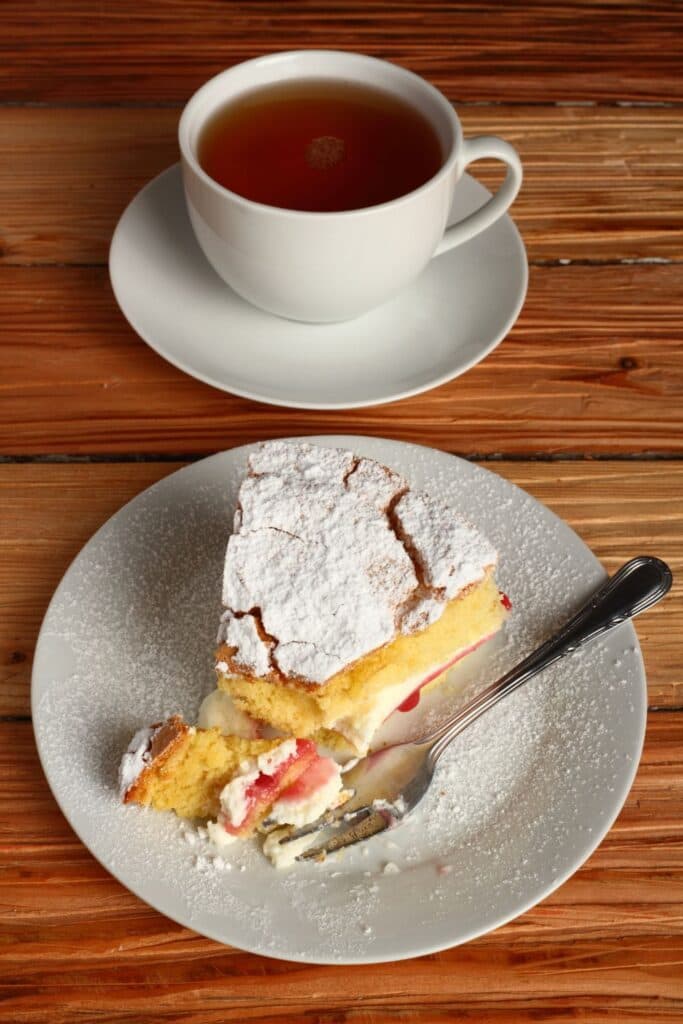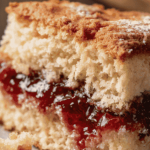Mary Berry’s Victoria Sponge is the quintessential British cake — soft, buttery, and filled with jam and cream. Named after Queen Victoria, who loved a slice with her afternoon tea, this cake embodies classic simplicity. With Mary Berry’s reliable recipe, you’ll achieve a light, golden sponge with a perfect balance of sweetness and creaminess every single time.
What is Mary Berry’s Victoria Sponge?
The Victoria Sponge, also known as Victoria Sandwich, is a traditional British cake made from two layers of airy sponge filled with jam and whipped cream or buttercream. Mary Berry’s version keeps things simple and elegant, using equal parts flour, sugar, butter, and eggs to ensure a consistent, beautifully textured sponge.

Other Mary Berry Popular Recipes
- Mary Berry 3-Layer Victoria Sponge
- Mary Berry Sponge Fruit Flan
- Mary Berry Gluten Free Victoria Sponge
- Mary Berry All-in-One Victoria Sponge
Why This Recipe is Worth Trying
- Timeless classic – A true staple of British baking.
- Light and fluffy texture – Perfectly balanced and not overly sweet.
- Simple ingredients – Made with pantry staples.
- Quick to prepare – Ready in under an hour.
- Ideal for any occasion – From birthdays to afternoon tea.
Essential Ingredients to Make Mary Berry Victoria Sponge
For the sponge:
- 225g self-raising flour
- 225g caster sugar
- 225g unsalted butter, softened
- 4 large eggs
- 2 tsp baking powder
- 2 tbsp milk
- 1 tsp vanilla extract (optional)
For the filling:
- 4 tbsp strawberry or raspberry jam
- 200ml double cream, whipped (or buttercream if preferred)
- Icing sugar, for dusting
Handy Kitchen Tools for Best Results
- Two 20cm round sandwich tins
- Electric whisk or stand mixer
- Cooling rack
- Offset spatula or palette knife
- Sieve for icing sugar
Step-by-Step Guide to Making Mary Berry Victoria Sponge
Step 1: Prepare the tins
Preheat oven to 180°C (160°C fan). Grease and line two 20cm sandwich tins with baking parchment.
Step 2: Mix the sponge ingredients
In a large bowl, beat butter, sugar, eggs, flour, baking powder, milk, and vanilla extract together using an electric whisk until light and smooth.
Step 3: Divide and bake
Divide the batter evenly between the tins. Smooth the tops and bake for 20–25 minutes until risen, golden, and springy to the touch.
Step 4: Cool the cakes
Let the cakes cool in tins for 5 minutes, then turn them onto a wire rack to cool completely.
Step 5: Prepare the filling
Whip the cream until soft peaks form. Alternatively, make buttercream by beating 100g butter with 200g icing sugar until smooth.
Step 6: Assemble the cake
Spread jam on one sponge and cream (or buttercream) on the other. Gently sandwich them together.
Step 7: Dust and serve
Lightly dust the top with icing sugar and serve with tea or coffee.

What I Got Wrong (And How I Fixed It)
- Overmixed batter – Made the sponge dense. Mixing just until smooth kept it fluffy.
- Didn’t line the tins properly – Cake stuck. Using baking paper fixed it.
- Cream melted – I didn’t cool the sponge enough. Waiting until fully cooled solved this.
Healthier Ways to Make Mary Berry Victoria Sponge
- Use light butter or olive spread to reduce fat.
- Swap cream for Greek yogurt filling.
- Reduce sugar by 10–15%.
- Choose low-sugar jam or fruit compote.
Ingredient Substitutions for Mary Berry Victoria Sponge
- Self-raising flour → 225g plain flour + 1 tsp baking powder.
- Butter → Margarine for a lighter texture.
- Double cream → Buttercream or mascarpone for variation.
- Jam → Lemon curd or berry compote for a tangy twist.
Pairing Ideas: What to Serve With Victoria Sponge
- Earl Grey tea – Classic and aromatic pairing.
- Fresh berries – Adds colour and freshness.
- Vanilla ice cream – Turns it into a dessert.
- Clotted cream – Adds indulgence.
- Fruit coulis – Enhances sweetness.
Expert Tips for Victoria Sponge Success
- Use room-temperature ingredients – Ensures smooth mixing.
- Weigh evenly – Equal layers bake uniformly.
- Avoid overbaking – Check a few minutes early for a moist crumb.
- Cool completely before filling – Prevents melting cream.
- Sieve icing sugar – For a fine, even dusting.
- Use fresh jam – Enhances flavour and texture.
Creative Ways to Customize Victoria Sponge
- Add lemon zest to the batter for freshness.
- Use buttercream and fresh fruit together for colour.
- Top with edible flowers for a tea-party look.
- Layer with chocolate ganache for indulgence.
- Make it mini-sized for individual servings.
Storing Victoria Sponge the Right Way
- Store in an airtight container at room temperature for up to 2 days.
- Refrigerate if using cream, and consume within 24 hours.
- Freeze unfilled sponges for up to 2 months. Thaw before assembling.
How to Reheat Victoria Sponge (If Needed)
- Microwave method – Warm slices for 10 seconds to soften.
- Oven method – Heat the unfilled sponge at 140°C for 5 minutes.
- From frozen – Thaw completely before filling and serving.
Nutritional Breakdown (per serving)
- Calories: ~395 kcal
- Protein: 6g
- Carbohydrates: 42g
- Fat: 22g
- Fibre: 1g
- Sugar: 30g
Mary Berry Victoria Sponge
The Victoria Sponge, also known as Victoria Sandwich, is a traditional British cake made from two layers of airy sponge filled with jam and whipped cream or buttercream. Mary Berry’s version keeps things simple and elegant, using equal parts flour, sugar, butter, and eggs to ensure a consistent, beautifully textured sponge.
- Prep Time: 20
- Cook Time: 25
- Total Time: 45 minutes
- Yield: 8 1x
- Category: Dessert
- Method: Baking
- Cuisine: British
Ingredients
For the sponge:
-
225g self-raising flour
-
225g caster sugar
-
225g unsalted butter, softened
-
4 large eggs
-
2 tsp baking powder
-
2 tbsp milk
-
1 tsp vanilla extract (optional)
For the filling:
-
4 tbsp strawberry or raspberry jam
-
200ml double cream, whipped (or buttercream if preferred)
-
Icing sugar, for dusting
Instructions
Preheat oven to 180°C (160°C fan). Grease and line two 20cm sandwich tins with baking parchment.
In a large bowl, beat butter, sugar, eggs, flour, baking powder, milk, and vanilla extract together using an electric whisk until light and smooth.
Divide the batter evenly between the tins. Smooth the tops and bake for 20–25 minutes until risen, golden, and springy to the touch.
Let the cakes cool in tins for 5 minutes, then turn them onto a wire rack to cool completely.
Whip the cream until soft peaks form. Alternatively, make buttercream by beating 100g butter with 200g icing sugar until smooth.
Spread jam on one sponge and cream (or buttercream) on the other. Gently sandwich them together.
Lightly dust the top with icing sugar and serve with tea or coffee.
FAQs
How do you make a Victoria sponge light and fluffy?
To make a Victoria sponge light and fluffy, use room-temperature ingredients and beat butter and sugar until pale and creamy before adding the eggs. Avoid overmixing once the flour is added.
Should a Victoria sponge have buttercream or fresh cream?
Traditionally, a Victoria sponge is filled with jam and either buttercream or whipped cream. Buttercream is better for longer storage, while fresh cream gives a lighter, fresher taste.
Why does my Victoria sponge crack on top?
A cracked sponge can happen if the oven temperature is too high or the cake is placed too close to the top. Bake at the correct temperature and avoid opening the oven door too early.
How do you know when a Victoria sponge is cooked?
The cake is ready when it’s golden, springs back when lightly pressed, and a skewer inserted in the centre comes out clean. Avoid overbaking to keep the sponge moist.
Wrapping It Up
Mary Berry’s Victoria Sponge is the definition of classic British baking — simple, light, and elegant. With its soft sponge, creamy filling, and sweet jam, this cake is a timeless favourite that never fails to impress.




